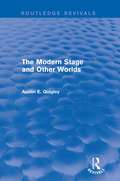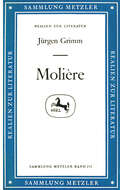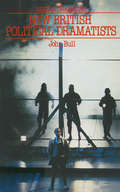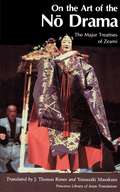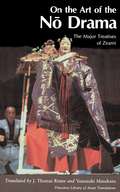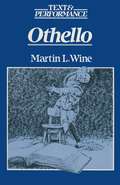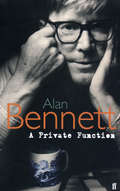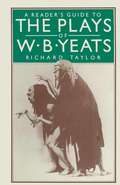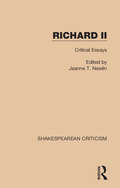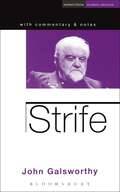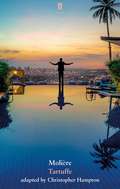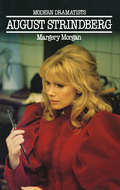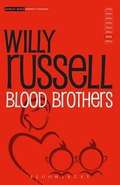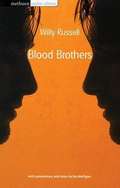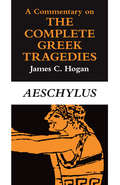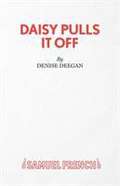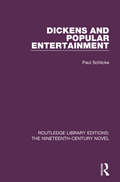- Table View
- List View
The Modern Stage and Other Worlds (Routledge Revivals)
by Austin E. QuigleyModern plays are strikingly diverse and, as a result, any attempt to locate an underlying unity between them encounters difficulties: to focus on what they have in common is often to overlook what is of primary importance in particular plays; to focus on their differences is to note the novelty of the plays without increasing their accessibility. In this study, first published in 1985, Austin E. Quigley takes as his paradigm case the relationship between the world of the stage and the world of the audience, and explores various modes of communication between domains. He asks how changes in the structure of the drama relate to changes in the structure of the theatre, and changes in the role of the audience. Detailed interpretations of plays by Pinero, Ibsen, Strindberg, Brecht, Ionesco, Beckett and Pinter question principles about the modern theatre and establish links between drama structure and theatre structure, theme, and performance space.
The Modern Stage and Other Worlds (Routledge Revivals)
by Austin E. QuigleyModern plays are strikingly diverse and, as a result, any attempt to locate an underlying unity between them encounters difficulties: to focus on what they have in common is often to overlook what is of primary importance in particular plays; to focus on their differences is to note the novelty of the plays without increasing their accessibility. In this study, first published in 1985, Austin E. Quigley takes as his paradigm case the relationship between the world of the stage and the world of the audience, and explores various modes of communication between domains. He asks how changes in the structure of the drama relate to changes in the structure of the theatre, and changes in the role of the audience. Detailed interpretations of plays by Pinero, Ibsen, Strindberg, Brecht, Ionesco, Beckett and Pinter question principles about the modern theatre and establish links between drama structure and theatre structure, theme, and performance space.
New British Political Dramatists: Howard Brenton, David Hare, Trevor Griffiths and David Edgar (Modern Dramatists)
by John BullAnyone interested in contemporary British theatre, everyone horrified by contemporary British society, should buy it, read it, and ponder the next move.' Plays and Players
On the Art of the No Drama: The Major Treatises of Zeami
by Masakazu Yamazaki J. Thomas RimerThis annotated translation is the first systematic rendering into any Western language of the nine major treatises on the art of the Japanese No theater by Zeami Motokivo (1363-1443). Zeami, who transformed the No from a country entertainment into a vehicle for profound theatrical and philosophical experience, was a brilliant actor himself, and his treatises touch on every aspect of the theater of his time. His theories, mixing philosophical and practical insights, often seem strikingly contemporary. Since their discovery early in this century. these secret treatises have been considered among the most valuable and representative documents in the history of Japanese aesthetics. They discuss subjects from the art of the playwright to the reciprocal nature of the relationship between performer and audience.
On the Art of the No Drama: The Major Treatises of Zeami (Princeton Library of Asian Translations #158)
by J. Thomas Rimer Masakazu YamazakiThis annotated translation is the first systematic rendering into any Western language of the nine major treatises on the art of the Japanese No theater by Zeami Motokivo (1363-1443). Zeami, who transformed the No from a country entertainment into a vehicle for profound theatrical and philosophical experience, was a brilliant actor himself, and his treatises touch on every aspect of the theater of his time. His theories, mixing philosophical and practical insights, often seem strikingly contemporary. Since their discovery early in this century. these secret treatises have been considered among the most valuable and representative documents in the history of Japanese aesthetics. They discuss subjects from the art of the playwright to the reciprocal nature of the relationship between performer and audience.
A Private Function
by Alan BennettThe Old CrowdA Private FunctionPrick Up Your Ears102 Boulevard HaussmannThe Madness of King GeorgeStarring characters as diverse as George III, Marcel Proust, Joe Orton, and a pig called Betty, Alan Bennett's masterful work for the screen gives as much enjoyment in the reading as it did in the viewing.This classic collection contains a new essay by Alan Bennett, besides the original introductions to A Private Function, Prick Up Your Ears and The Madness of King George.Two companion volumes of Alan Bennett's TV plays are published as Me, I'm Afraid of Virginia Woolf and Rolling Home.
Richard II: Critical Essays (Shakespearean Criticism)
by Jeanne T. NewlinOriginally published in 1984. The four parts of this collection of articles, from 1601 to the 1970s, look at the historical and political dynamics of the play, the play in the theatre, the psychology of its characters, and its poetry and rhetoric. Bringing together the best that was written about Richard II, this volume represents the collective wisdom of Shakespeare scholars and provides the most insightful criticism in one place. An unpopular play for many years due to the perceived weak main character and the theme of deposition, the play later gained popularity and interest in its psychology and political investigation. The poetry in particular has garnered enthusiastic response and is mentioned in most of the pieces included here.
Richard II: Critical Essays (Shakespearean Criticism)
by Jeanne T. NewlinOriginally published in 1984. The four parts of this collection of articles, from 1601 to the 1970s, look at the historical and political dynamics of the play, the play in the theatre, the psychology of its characters, and its poetry and rhetoric. Bringing together the best that was written about Richard II, this volume represents the collective wisdom of Shakespeare scholars and provides the most insightful criticism in one place. An unpopular play for many years due to the perceived weak main character and the theme of deposition, the play later gained popularity and interest in its psychology and political investigation. The poetry in particular has garnered enthusiastic response and is mentioned in most of the pieces included here.
Strife: A Drama In Three Acts (Student Editions)
by John Galsworthy Non WorrallJohn Galsworthy (1867-1933), novelist and dramatist, is most widely known as the author of The Forsyte Saga, but recent productions testify to the power that his plays still exert over modern audiences and the strength and relevance of the issues he raiseStrife charts the progress of an industrial strike, seen from both the workers' and directors' points of view as well as the directors and looks at the relationship between wives across the class divide as they attempt to persuade their obdurate husbands to broker a deal.
Tartuffe
by Christopher HamptonFrench billionaire Orgon, relocated to Los Angeles with his family, has fallen under the spell of Tartuffe, a radical American evangelist. So comprehensively is he hoodwinked that Tartuffe looks set to steal his fortune, drive away his son, seduce his wife and marry his daughter.Molière's classic comedy, adapted by Christopher Hampton and directed by the former dramaturg of the French People's National Theatre, Gérald Garutti, premiered in May 2018, the West End's first dual language theatre production.This is a bilingual edition of the text.
Blood Brothers
by Willy RussellA Liverpudlian West Side Story: twin brothers are separated at birth because their mother cannot afford to keep them both. She gives one of them away to wealthy Mrs Lyons and they grow up as friends in ignorance of their fraternity until the inevitable quarrel unleashes a blood-bath. 'Willy Russell is less concerned with political tub-thumping than with weaving a close-knit story about the working of fate and destiny. It carries one along with it in almost unreserved enjoyment Guardian One of the longest-running and most successful ever West End musicals , Blood Brothers premiered at the Liverpool Playhouse in January 1983.
Blood Brothers - A Musical (Methuen Drama Student editions) (PDF)
by Willy RussellA Liverpudlian West Side Story, Blood Brothers is the story of twin brothers separated at birth because their mother cannot afford to keep them both. One of them is given away to wealthy Mrs Lyons and they grow up as friends in ignorance of their fraternity until the inevitable quarrel unleashes a blood-bath.nbsp;
Blood Brothers (PDF)
by Willy RussellA Liverpudlian West Side Story: twin brothers are separated at birth because their mother cannot afford to keep them both. She gives one of them away to wealthy Mrs Lyons and they grow up as friends in ignorance of their fraternity until the inevitable quarrel unleashes a blood-bath. 'Willy Russell is less concerned with political tub-thumping than with weaving a close-knit story about the working of fate and destiny. It carries one along with it in almost unreserved enjoyment Guardian One of the longest-running and most successful ever West End musicals , Blood Brothers premiered at the Liverpool Playhouse in January 1983.
A Commentary on The Complete Greek Tragedies. Aeschylus: Aeschylus
by James C. HoganThis commentary offers a rich introduction and useful guide to the seven surviving plays attributed to Aeschylus. Though it may profitably be used with any translation of Aeschylus, the commentary is based on the acclaimed Chicago translations, The Complete Greek Tragedies, edited by David Grene and Richmond Lattimore. James C. Hogan provides a general introduction to Aeschylean theater and drama, followed by a line-by-line commentary on each of the seven plays. He places Aeschylus in the historical, cultural, and religious context of fifth-century Athens, showing how the action and metaphor of Aeschylean theater can be illuminated by information on Athenian law athletic contests, relations with neighboring states, beliefs about the underworld, and countless other details of Hellenic life. Hogan clarifies terms that might puzzle modern readers, such as place names and mythological references, and gives special attention to textual and linguistic issues: controversial questions of interpretation; difficult or significant Greek words; use of style, rhetoric, and commonplaces in Greek poetry; and Aeschylus's place in the poetic tradition of Homer, Hesiod, and the elegiac poets. Practical information on staging and production is also included, as are maps and illustrations, a bibliography, indexes, and extensive cross-references between the seven plays. Forthcoming volumes will cover the works of Sophocles and Euripides.
A Commentary on The Complete Greek Tragedies. Aeschylus: Aeschylus
by James C. HoganThis commentary offers a rich introduction and useful guide to the seven surviving plays attributed to Aeschylus. Though it may profitably be used with any translation of Aeschylus, the commentary is based on the acclaimed Chicago translations, The Complete Greek Tragedies, edited by David Grene and Richmond Lattimore. James C. Hogan provides a general introduction to Aeschylean theater and drama, followed by a line-by-line commentary on each of the seven plays. He places Aeschylus in the historical, cultural, and religious context of fifth-century Athens, showing how the action and metaphor of Aeschylean theater can be illuminated by information on Athenian law athletic contests, relations with neighboring states, beliefs about the underworld, and countless other details of Hellenic life. Hogan clarifies terms that might puzzle modern readers, such as place names and mythological references, and gives special attention to textual and linguistic issues: controversial questions of interpretation; difficult or significant Greek words; use of style, rhetoric, and commonplaces in Greek poetry; and Aeschylus's place in the poetic tradition of Homer, Hesiod, and the elegiac poets. Practical information on staging and production is also included, as are maps and illustrations, a bibliography, indexes, and extensive cross-references between the seven plays. Forthcoming volumes will cover the works of Sophocles and Euripides.
A Commentary on The Complete Greek Tragedies. Aeschylus: Aeschylus
by James C. HoganThis commentary offers a rich introduction and useful guide to the seven surviving plays attributed to Aeschylus. Though it may profitably be used with any translation of Aeschylus, the commentary is based on the acclaimed Chicago translations, The Complete Greek Tragedies, edited by David Grene and Richmond Lattimore. James C. Hogan provides a general introduction to Aeschylean theater and drama, followed by a line-by-line commentary on each of the seven plays. He places Aeschylus in the historical, cultural, and religious context of fifth-century Athens, showing how the action and metaphor of Aeschylean theater can be illuminated by information on Athenian law athletic contests, relations with neighboring states, beliefs about the underworld, and countless other details of Hellenic life. Hogan clarifies terms that might puzzle modern readers, such as place names and mythological references, and gives special attention to textual and linguistic issues: controversial questions of interpretation; difficult or significant Greek words; use of style, rhetoric, and commonplaces in Greek poetry; and Aeschylus's place in the poetic tradition of Homer, Hesiod, and the elegiac poets. Practical information on staging and production is also included, as are maps and illustrations, a bibliography, indexes, and extensive cross-references between the seven plays. Forthcoming volumes will cover the works of Sophocles and Euripides.
A Commentary on The Complete Greek Tragedies. Aeschylus: Aeschylus
by James C. HoganThis commentary offers a rich introduction and useful guide to the seven surviving plays attributed to Aeschylus. Though it may profitably be used with any translation of Aeschylus, the commentary is based on the acclaimed Chicago translations, The Complete Greek Tragedies, edited by David Grene and Richmond Lattimore. James C. Hogan provides a general introduction to Aeschylean theater and drama, followed by a line-by-line commentary on each of the seven plays. He places Aeschylus in the historical, cultural, and religious context of fifth-century Athens, showing how the action and metaphor of Aeschylean theater can be illuminated by information on Athenian law athletic contests, relations with neighboring states, beliefs about the underworld, and countless other details of Hellenic life. Hogan clarifies terms that might puzzle modern readers, such as place names and mythological references, and gives special attention to textual and linguistic issues: controversial questions of interpretation; difficult or significant Greek words; use of style, rhetoric, and commonplaces in Greek poetry; and Aeschylus's place in the poetic tradition of Homer, Hesiod, and the elegiac poets. Practical information on staging and production is also included, as are maps and illustrations, a bibliography, indexes, and extensive cross-references between the seven plays. Forthcoming volumes will cover the works of Sophocles and Euripides.
A Commentary on The Complete Greek Tragedies. Aeschylus
by James C. HoganThis commentary offers a rich introduction and useful guide to the seven surviving plays attributed to Aeschylus. Though it may profitably be used with any translation of Aeschylus, the commentary is based on the acclaimed Chicago translations, The Complete Greek Tragedies, edited by David Grene and Richmond Lattimore. James C. Hogan provides a general introduction to Aeschylean theater and drama, followed by a line-by-line commentary on each of the seven plays. He places Aeschylus in the historical, cultural, and religious context of fifth-century Athens, showing how the action and metaphor of Aeschylean theater can be illuminated by information on Athenian law athletic contests, relations with neighboring states, beliefs about the underworld, and countless other details of Hellenic life. Hogan clarifies terms that might puzzle modern readers, such as place names and mythological references, and gives special attention to textual and linguistic issues: controversial questions of interpretation; difficult or significant Greek words; use of style, rhetoric, and commonplaces in Greek poetry; and Aeschylus's place in the poetic tradition of Homer, Hesiod, and the elegiac poets. Practical information on staging and production is also included, as are maps and illustrations, a bibliography, indexes, and extensive cross-references between the seven plays. Forthcoming volumes will cover the works of Sophocles and Euripides.
A Commentary on The Complete Greek Tragedies. Aeschylus: Aeschylus
by James C. HoganThis commentary offers a rich introduction and useful guide to the seven surviving plays attributed to Aeschylus. Though it may profitably be used with any translation of Aeschylus, the commentary is based on the acclaimed Chicago translations, The Complete Greek Tragedies, edited by David Grene and Richmond Lattimore. James C. Hogan provides a general introduction to Aeschylean theater and drama, followed by a line-by-line commentary on each of the seven plays. He places Aeschylus in the historical, cultural, and religious context of fifth-century Athens, showing how the action and metaphor of Aeschylean theater can be illuminated by information on Athenian law athletic contests, relations with neighboring states, beliefs about the underworld, and countless other details of Hellenic life. Hogan clarifies terms that might puzzle modern readers, such as place names and mythological references, and gives special attention to textual and linguistic issues: controversial questions of interpretation; difficult or significant Greek words; use of style, rhetoric, and commonplaces in Greek poetry; and Aeschylus's place in the poetic tradition of Homer, Hesiod, and the elegiac poets. Practical information on staging and production is also included, as are maps and illustrations, a bibliography, indexes, and extensive cross-references between the seven plays. Forthcoming volumes will cover the works of Sophocles and Euripides.
Daisy Pulls It Off (Acting Edition Series (PDF))
by Denise DeeganDaisy Meredith, the new girl, is the first scholarship student to attend the Grangewood School for Girls. The privileged students are determined to make Daisy look bad in the eyes of the administration. The administration has its own problems, financial ones. Daisy wins over her chums and saves the school when she cracks a secret code, finds a treasure and saves the life of her chief nemesis all on the same night!
Dickens and Popular Entertainment (Routledge Library Editions: The Nineteenth-Century Novel)
by Paul SchlickeFirst published in 1985. Dickens was a vigorous champion of the right of all men and women to carefree amusements and dedicated himself to the creation of imaginative pleasure. This book represents the first extended study of this vital aspect of Dickens’ life and work, exploring how he channelled his love of entertainment into his artistry. This study offers a challenging reassessment of Nicholas Nickleby, The Old Curiosity Shop and Hard Times. It shows the importance of entertainment to Dickens’ journalism and presents an illuminating perspective on the public readings which dominated the last twelve years of his life. This book will be of interest to students of literature.
